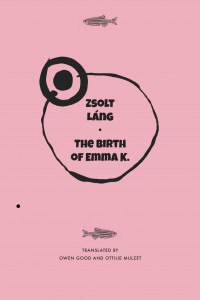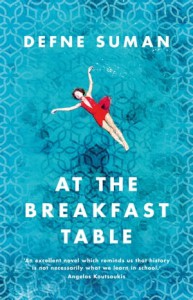In these brilliant feats of literature, three writers drive the vehicle of language through time and space to learn profound, painful, and complex truths about history and our inheritance of it. From Romania, Zsolt Láng braids imagination and reality to paint multitudinous portraits of the individual and society. From Turkey, Defne Suman tracks a family through present hauntings into the dark, deceptive recesses of the national past. From Guatemala, Eduardo Halfon opens up the question of a name as it is passed down through generations, delving into the chasm between who we are and what we are called. Read on to find out more. Also, for the first time since the magazine’s inception, we have included affiliate links to books under review. Please take note that we may receive a small commission for purchases made through these links, which will go toward supporting our mission of advocating for greater inclusiveness in world literature. Other ways include joining our Book Club or becoming a sustaining member.

The Birth of Emma K. by Zsolt Láng, translated from the Hungarian by Owen Good and Ottilie Mulzet, Seagull Books, 2022
Review by Rachel Stanyon, Senior Copy Editor
What a swirling, kaleidoscopic reading experience. Zsolt Láng’s The Birth of Emma K. is a cracker of a book—albeit one that forces readers to commit to intricate twists and turns, before arriving at meaning within its refracted reflections on modern life.
Láng—a Hungarian writer from Transylvania, Romania—presents a plethora of perspectives in these twelve short stories, but unites them through a shared narrative style that constantly questions and blurs one’s sense of reality, while never quite descending into fantasy. The stories themselves are often equivocal, with endings that invite conjecture or remain opaque, and the plotlines that lead to these often ambiguous conclusions are full of hypotheticals, the language replete with conditionals and revisions, making every situation feel provisional and emphasising the contingent nature of the world.
The characters, meanwhile, are often driven by love, lust, hatred, or other forces of reproduction, but often also seem adrift, questioning their existence. This is evident from the very opening of the collection, which sees God observing and vacillating over the degree to which he should—and is able to—intervene in the lives of his creations. This version of God is not only not omnipotent, he has a heightened, anxiety-inducing awareness of the potentially negative consequences of his actions, and prays to another higher being that gave him his “not-quite-absolute power.” In the collection’s arch postmodernist style, which seems to use this initial framing by a semi-powerful God to parallel the figure of the author, scenarios are constantly retracted and resketched, and we are often told what is not happening, rather than what is:
That our Lord was sitting or standing about on the side of Gellért hill, at the top of Számadó street near the Sióvölgyi family’s villa, would be an exaggeration. Our Lord doesn’t tend to sit or stand about, he floats. But just so we aren’t constantly searching for words and forever refining what we come up with, let’s postulate that we’re not talking about the Father or the Holy Ghost, we’re talking about the Son, and then we can confidently say that there stood the Son of God…
From this opening story, we switch in the following tale (the only one to take place well outside the shifting borders of Romania, and the most realist of the collection) to a very human protagonist adrift in Rome, who briefly anchors himself in the life of a woman who is caught up in the mafia and is seemingly obsessed with butter. The stories constantly flutter on the border of absurdism and magic realism, but the intentionally tentative and conditional language in which the stories are written—the way they often glide in and out of daydreams—prompts questions as to whether fantastical elements are merely figments of the characters’ imaginations. In “Like a Shaggy Ink Cap Mushroom,” for example, a police inspector stares at his own gravestone, raising the question of whether he is now a ghost, whether he is so obsessed with death that he had the stone made while still alive, or, then again, whether—like so many characters and places across the stories—he merely shares the name on the tombstone. Again and again in the stories, the hypothetical glides into the actual and back again, sometimes creating the kind of frenzied experience of reading through the eyes of a madman conjured in Faulkner’s The Sound and the Fury—such as in “Madhouse,” in which a psychiatrist joins the bedlam of the institution in which he works; or the frantic, labyrinthine, and menacing atmosphere of Mikhail’s Bulgakov’s The Master and Margerita—such as in “Before Midnight,” in which the lovesick central character is unwittingly plunged into a lecture where he is expected to discuss the significance of Béla Bartók, in Romanian, to an antagonistic audience. Although we know the protagonist to be a musician, we never quite find out whether he is in fact an expert on Bartók, or even if he can usually speak Romanian; the unexplained and the impossible perform a constant, tense dance.
Stories such as this, and particularly “Open Lesson,” in which an ambitious teacher attempts to have her students re-enact the unification of three Romanian realms only for it to descend into ahistorical mayhem, tease out some of the complex and contested histories of Transylvania, Hungary, Romania, and even Moldova—as well as the religious, cultural, political, and linguistic tensions that still exist in these regions. Many of the stories also refer to present or former corruption, casual self-interest, or mere incompetence within ruling infrastructures, and many of the interpersonal relationships are characterised by violence, through which the collection subtly criticises existing hierarchies and inequalities without hitting the reader over the head with simplistic moral lessons or pretending at sweeping solutions. The stories emphasise the multiplicity of competing perspectives, and the contingent, accidental, and often corrupted nature of reality. Yet, like the not-quite omnipotent God of the opening stories, the characters have a degree of agency, and can—often in the very last sentence of a story—change their direction or learn from their experiences, even if the not-quite omniscient reader is left somewhat unsure of what they have learned or where they are now going.
Even within a single story, many narrative tendrils unfurl, some of which cling to a solid foundation to create structure, while others are left blowing in the breeze. The multiplicity of storylines within each piece points to the way people swirl around each another, sometimes coming into contact only tangentially, sometimes interconnecting, and sometimes buffeting against one another. Many stories seem to begin in medias res, only to immediately shift their attention to a subplot or turn to what appeared to be a supporting actor, while others are told through the lens of neighbouring characters about whom we learn virtually nothing. The eponymous character of the titular story, for example, does not appear until we are already nearly a quarter of the way into what is ostensibly her narrative. The sheer amount of circumstantial and personal detail packed into each page by the narrators creates an at-times dizzying convolution of information that sometimes crystallizes into triumphant vignettes, but occasionally just ends up feeling . . . well, convoluted. Credit must be given to the translators Owen Good and Ottilie Mulzet for unpicking and holding aloft all these threads—which Láng himself sometimes intentionally drops—just long enough to convey both the rich tapestry and frayed ends to the English-speaking reader.
The Story of Emma K. sucks you in, whirls you around, and then, much like Emma K. herself, spits you out into a world that is complex and harsh, yet compelling and seductive—bounded by forces beyond our control, but in which we must inevitably take part. Like life itself, this collection will at times leave you dazed and confused, but craving more.
Click here to order your copy of The Birth of Emma K.

At the Breakfast Table by Defne Suman, translated from Turkish by Betsy Göksel, Head of Zeus, 2022
Review by Irmak Ertuna Howison, Educational Arm Assistant
Readers of Turkish literature know well that the nation’s repressed history becomes a mystery to be solved in contemporary novelists’ works. While the official history and the mainstream media deny and erase all narratives that speak truth to power, novelists resurface historical moments to give voice to repressed minorities, fictionalizing ways of reconciling with the past. Of course, the first step of reconciliation is acknowledging “unspeakable” truths. Defne Suman’s novel At the Breakfast Table, her second to be translated into English, thematizes precisely this difficult confrontation. Set in Buyukada, one of Princes’ islands, and narrated through the multiple different viewpoints of its characters, the novel describes how an intergenerational trauma can fester if left untended.
The occasion of the hundredth birthday of Shirin Saka gathers family members and a family friend, who happens to be a journalist, to the island. Shirin, an artist whose place in the spotlight has long passed, is the matriarch of a family with multiple tragedies behind them—which are slowly revealed during the course of the novel. Though Shirin initially seems uninterested in acknowledging the past’s haunting, her grandson Fikret, bearing the inheritance of this familial weight, is convinced that the dark cloud over the family results from a secret he is determined to unearth.
The novel opens with Fikret going missing from the island mansion, upon which his daughter Celine tries to convince their guest, Burak, to go searching for him. Celine, a hopelessly romantic young woman, is attracted to Burak; Burak, on the other hand, is still in love with his ex-lover Nur—Fikret’s sister and Shirin’s granddaughter. While each character has their own romantic secrets to work through, they slowly come to realize that their lives are intertwined with the larger social history of their country. In one of Burak’s memories, he laments that even in his happiest moment with Nur, he was unable to fully immerse himself in love because his country has never let him forget the sad political reality. In a sense, Turkey is also responsible for failures in their relationships, having irrevocably shaped their psyches.
In an almost dream-like fashion, the memories start to seep into the present. Sadık Usta, Shirin Saka’s servant, is the gatekeeper to the past, but as a main actor in its unsettling events, Sadık is reluctant to dig into what he has so carefully buried. He prefers to be invisible, noting: “Madam Shirin has many photographs. I am always surprised when I see myself in one of them, in the background somewhere, caught in a doorway like a ghost.” Sadık, however, is not a ghost, but a living monument to an event erased from both the family and nation’s history. Suman skillfully turns this story about intergenerational trauma into a page-turner mystery; each chapter, told from a different character’s point of view, contributes a piece of the puzzle, transporting the reader to different moments in the chronology of modern Turkey.
One of Suman’s skills is her vivid and realistic depiction of Istanbul, especially its island Buyukada. While reading the novel, you can almost taste the lemon-squeezed mussel dolmas, cool down with an ice-cold beer overlooking the Marmara Sea, and get upset at the tourist crowds creating havoc. But Suman doesn’t fall into the trap of romanticizing the city, loved and hated equally by its inhabitants. Istanbul is, after all, a place of opposites and contradictions. Its snow-covered dreamland can quickly turn into muddy slush. Eating those delicious fresh mussels from Marmara Sea is also like “eating a leaking battery.” Young people make love on one of the many hills of the city while on another, women start hunger strikes to protest against isolation cells for political prisoners. It is refreshing to read a Turkish novel that presents Istanbul with all its infuriating and delightful details, and Betsy Göksel’s smooth English translation does justice to Suman’s elegant prose.
At the thematic heart of this work lies the difficulty of acknowledging the past when the “truth” is manufactured by the state and the media. Readers attuned to contemporary Turkish politics know that independent media in the country faces many challenges. What they might not realize, however, is that this is not a recent development; Turkish mainstream media has always been more or less in line with official ideology. In At the Breakfast Table, it is no surprise that both Burak and Nur are journalists, their youthful ideals having quickly evaporated in light of how the truth gets twisted. Before quitting the profession altogether, Nur realizes that: “Journalism was not about revealing the truth or calling people out or encouraging the powerful to admit their failings. It was about fabricating a truth that didn’t exist and then watching how that truth became the accepted version of reality.” In a telling change, Nur becomes a novelist; it is ironic that novelists, whose profession it is to create fictions, are, in fact, the ones loyal to repressed truths.
At the Breakfast Table captivates readers with its plot but engages them on a deeper level with its historic and psychological detail. Under the rule of an authoritarian regime, Suman, along with many contemporary Turkish authors, are assigned the immense task of imagining how Turkey and its citizens can face their past. The story of the Saka family results from this vital work, untying the painful knot of a national history to open a discussion on what has been willfully forgotten.
Click here to order your copy of At the Breakfast Table.

Canción by Eduardo Halfon, translated from the Spanish by Lisa Dillman and Daniel Hahn, Bellevue Literary Press, 2022
Review by Andrea Blatz, Copy Editor
In Eduardo Halfon’s newest book to appear in English, the narrator is also named Eduardo Halfon. The fact of a name goes on to play an important role in Canción, which details one’s struggles with questions of identity, belonging, and origin. Throughout this gripping text, the author explores how a family’s history continues to impact the present, revealing the weight—or burden—behind a name, underlined by the three Eduardo Halfons: the author, the narrator, and the narrator’s grandfather. This commonality blurs the line between fiction and autobiography, and similarly blends together personal and national histories.
The book begins with Eduardo Halfon, a Guatemalan-born Jew, participating in a Lebanese writers’ conference: “I arrived in Tokyo disguised as an Arab,” but able to speak very little Arabic. Halfon was invited because of his supposed heritage: his grandfather was born in Beirut. From the very beginning, we get glimpses of the narrator’s fluid identity:
A Jewish writer, yes. A Guatemalan writer, obviously. A Latin American writer, of course. A Central American writer, less and less. A U.S. writer, more and more. A Spanish writer, when traveling on that passport was desirable. A Polish writer, on one occasion, at a Barcelona bookstore that insisted—insists—on shelving my books in the Polish literature section. A French writer, since I lived for a time in Paris[.]
However, it is difficult to tell if Halfon actually believes these titles apply to him, or if he simply wears them superficially, as disguises, to fit himself into different circumstances. Indeed, he states that “playing an Arab for a day at a conference” would allow him to see the country.
Halfon’s identity has shifted during his previous travels as well, as he uses each consecutive location for different purposes. In New York and in Paris, he becomes a historian to search the archives for the boat his grandfather first took to the United States—and simultaneously learns that his grandfather was actually Syrian, but that “the immigration officer had corrected or doubted himself: he crossed the word [Syrian] out and wrote over it, by hand, the word Lebanese. And, you see, my grandfather always said he was Lebanese [. . .] although Lebanon, as a country, was not founded until 1920, three years after he and his siblings left Beirut.” In Japan, on the other hand, Halfon takes on the role of a publicist, trying to spread the word about his grandfather’s true nationality.
Throughout the text, identity is flexible and unsettled, determinant on not only will but also circumstance, and its shifts are reflected in the narrative’s unfurling as the author shuffles the plot through time and space. While in the narrator is, in the text’s present, in Tokyo, much of his telling takes place in a bar in the Guatemala of recent past, where Halfon learns more about his grandfather’s kidnapping. This then takes us back to 1967, in the room where his grandfather was held for thirty-five days. Lurking in the background of this thread is the Guatemalan Civil War, as guerrillas were violently trying to gain control of the country, and it is in the bar where we learn the meaning of the title: Canción is the name of the man who kidnapped his grandfather. Halfon explains this name:
They called him Canción because he used to be a butcher. Not because he was a musician. Not because he was a singer (he couldn’t even sing). [. . .] And his nickname, then, was nothing more than an alliteration between the words in Spanish for butcher (carnicero) and song (canción). Or at least that’s what some of his friends claimed. Others, however, said that he got his nickname due to his peculiar and melodic way of talking. And still others, perhaps the most intrepid ones, attributed it to his capricious nature of always confessing too much, of singing more than he should.
The multiplicity of the name veers between fact and invention, as it seems that some of these meanings are merely concocted in an attempt to come to terms with a butcher—whose vocation of killing extends beyond animals—carrying such a pretty name. Throughout the text, the narrator’s struggle with his own name also tackles this discrepancy; at his grandfather’s gravesite, he can’t help but see himself already buried under the same tombstone. While the narrator tries to break free, to be his own person, his name constantly denies him the ability to move on, and he is forever stuck in the past.
His grandfather’s story eventually circles back to the present, where Halfon meets the Japanese woman running the conference—Aiko, whose grandfather was in Hiroshima when the atomic bomb was dropped on the city. When Aiko was a young girl, she saw her grandfather’s scars, but did not know their origin. Halfon’s grandfather bears mental scars of his trauma, while Aiko’s grandfather bears physical scars: “the bomb had forever marked his skin not with just any old article of clothing, not with a shirt or jacket, but with one of the traditional kimonos he had inherited from his father and his grandfather, and which no longer even existed. The bomb had incinerated it, Aiko said. Or, rather, the bomb had embedded it in his skin.” Here, Halfon underlines how the past can weigh down a family through generations, even—or especially—if it is unspoken. In this, Aiko and Halfon form a bond; despite the vastly different experiences of their grandfathers, they both begin to understand “the marks they then wear on their skin for the rest of their lives.”
Throughout the text, the author weaves together these threads of past and present, Japan and Guatemala, the narrator and his grandfather. Lisa Dillman and Daniel Hahn’s translation, completed in consultation with Halfon, gracefully calls attention to Halfon’s insightful depiction of an identity-forming journey.
Click here to order your copy of Cancion.
*****
Read more on the Asymptote blog:

